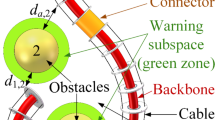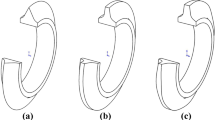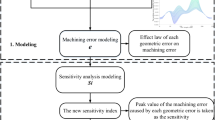Abstract
In order to improve the accuracy of position and direction of the tool axis vector and the controlling accuracy of cutter contacting (CC) paths between the cutter and workpiece in the traditional five-axis NURBS interpolation method, a five-axis Tri-NURBS spline interpolation method is proposed in this paper. Firstly, the spline interpolation instruction format is proposed, which includes three spline curves, the CC point spline, the tool center point spline, and the tool axis point spline. The next interpolation parameter is calculated based on the tool center point spline combined with the conventional parametric interpolation method. Different from the traditional spline interpolation using the same interpolation parameter for all spline curves, the idea of equal ratio configuration of parameters is proposed in this paper to obtain the next interpolation parameter of each spline curve. The next interpolation tool center point, tool axis point, and CC point on the above three spline curves can be obtained by using different interpolation parameters, so as to improve the accuracy of position and direction of the tool axis vector. Secondly, the producing mechanism of the nonlinear error of CC paths of the traditional spline interpolation is analyzed and the mathematical calculation model of the nonlinear error is established. And then, the compensation and correction method of nonlinear error is also proposed to improve the controlling accuracy of CC paths. In this method, the next CC point on the cutter can be first obtained according to the next interpolation tool center point, tool axis point, and CC point on the three spline curves. And then, the error compensation vector is determined with the two next CC points. To correct the nonlinear error between the next CC point on the cutter and the CC point spline curve, the cutter is translated so that the two next CC points can coincide. In the end, the new tool center point and tool axis point after translation can be calculated to obtain the motion control coordinates of each axis of the machine tool. The MATLAB and VERICUT software are used as a simulation of the real machining data. The results show that the proposed method can effectively reduce the nonlinear error of CC paths. It has high practical value for five-axis machining in effectively controlling the accuracy of CC paths and improving the machining accuracy of complex surfaces.























Similar content being viewed by others
Availability of data and material
The datasets used or analyzed during the current study are available from the corresponding author on reasonable request.
Code availability
The codes used or analyzed during the current study are available from the corresponding author on reasonable request.
References
Li YQ, Chen YX, Chen Q (2012) Research on nonlinear error analysis and overproof processing method in five-axis NC machining with dual turntable. Appl Mech Mater 1498:3662–3666
Jung HC, Hwang JD, Park KB, Jung YG (2011) Development of practical postprocessor for 5-axis machine tool with non-orthogonal rotary axes. J Cent South Univ T 01:159–164
Takeuchi Y, Idemura T, Sata T (1991) 5-axis control machining and grinding based on solid model. CIRP Ann Manuf Technol 40(1)
Wu DZ (2007) Nonlinear error control and post-processing of five-axis NC machining. Shanghai Jiaotong Univ Chin Ed
Chen HS, Chang CC (2007) Design of a generic five-axis postprocessor based on generalized kinematics model of machine tool. Int J Mach Tool Manu 47(3):537–545
Jun C, Cha K, Lee Y (2003) Optimizing tool orientations for 5-axis machining by configuration-space search method. Comput Aided Des 35(6):549–566
Sencer B, Altintas Y, Croft E (2009) Modeling and control of contouring errors for five-axis machine tools-part I: modeling. J Manuf Sci Eng ASME 131:0310061–0310068
Tutunea-Fatan OR, Bhuiya MS (2011) Comparing the kinematic efficiency of five-axis machine tool configurations through nonlinearity errors. Comput Aided Des 43(9):1163–1172
Liang H, Hong H, Svoboda J (2003) A cutter orientation modification method for the reduction of non-linearity errors in five-axis CNC machining. Mach Sci Technol 7(1):1–18
Ho MC, Hwang YR, Hu CH (2003) Five-axis tool orientation smoothing using quaternion interpolation algorithm. Int J Mach Tool Manu 43(12):1259–1267
Liang H, Hong H, Svoboda J (2002) A combined 3D liner and circular interpolation technique for multi-axis CNC machining. J Manuf Sci Eng ASME 124:305–312
Hong XY, Hong RJ, Lin XC (2019) Tool orientations’ generation and nonlinear error control based on complex surface meshing. Int J Adv Manuf Tech 105:4279–4288
Xu RF, Chen X, Zheng GM, Chen ZT (2017) A tool orientation smoothing method based on machine rotary axes for five-axis machining with ball end cutters. Int J Adv Manuf Tech 92(7):3615–3625
Tutunea-Fatan OR, Bhuiya MSH (2011) Comparing the kinematic efficiency of five-axis machine tool configurations through nonlinearity errors. Comput Aided Des 43(9):1163–1172
Zhou YS, Chevychen ZZ, Fang ZX (2015) Nonlinearity error analysis with the application of the envelope surface in five-axis CNC machining. IFAC PapersOnLine 48(3):675–679
Li JG, Zhouyang HS, Lou YJ (2013) Tool path optimization in postprocessor of five-axis machine tools. Int J Adv Manuf Tech 68(9–12):2683–2691
Zhang K, Zhang LQ, Yan YC (2016) Single spherical angle linear interpolation for the control of non-linearity errors in five-axis flank milling. Int J Adv Manuf Tech 87(9–12):3289–3299
Li DD, Zhang WM, Zhou W, Shang TF, Fleischer J (2018) Dual NURBS path smoothing for 5-axis linear path of flank milling. Int J Precis Eng Man 19(12):1811–1820
Zhang J, Zhang LQ, Zhang K, Mao J (2016) Double NURBS trajectory generation and synchronous interpolation for five-axis machining based on dual quaternion algorithm. Int J Adv Manuf Tech 83(9–12):2015–2025
Zhou J, Sun Y, Guo D (2014) Adaptive federate interpolation with multiconstraints for five-axis parametric toolpath. Int J Adv Manuf Technol 71(9–12):1873–1882
Piegl L, Tiller W (1997) B-spline curves and surfaces. The NURBS book. Springer, Berlin Heidelberg, Berlin, pp 81–116
Funding
This research was supported by Guangxi Natural Science Foundation under Grant No.2021GXNSFAA220019 and Professor Kaihong Zhou received a grant from the National Natural Science Foundation of China (Award Number: 52075110).
Author information
Authors and Affiliations
Contributions
The overarching research goals were developed by Liangji Chen, Zisen Wei, and Longfei Ma. Liangji Chen, Zisen Wei, and Longfei Ma established the models and calculated the predicted consequence. Liangji Chen and Zisen Wei analyzed the calculated results. The initial draft of the manuscript was written by Liangji Chen, Zisen Wei, and Longfei Ma.
Corresponding author
Ethics declarations
Consent for publication
On behalf of my coauthors, I submit our manuscript entitled “Five-axis Tri-NURBS spline interpolation method considering compensation and correction of the nonlinear error of cutter contacting paths” to “The International Journal of Advanced Manufacturing Technology” for publishing.
Conflict of interest
The authors declare no competing interests.
Additional information
Publisher's Note
Springer Nature remains neutral with regard to jurisdictional claims in published maps and institutional affiliations.
Rights and permissions
About this article
Cite this article
Chen, L., Wei, Z. & Ma, L. Five-axis Tri-NURBS spline interpolation method considering compensation and correction of the nonlinear error of cutter contacting paths. Int J Adv Manuf Technol 119, 2043–2057 (2022). https://doi.org/10.1007/s00170-021-08208-7
Received:
Accepted:
Published:
Issue Date:
DOI: https://doi.org/10.1007/s00170-021-08208-7




